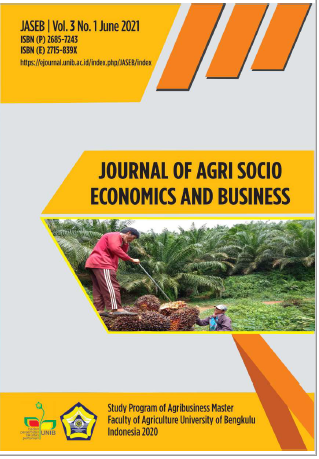Main Article Content
Abstract
Article Details
An author who publishes in the Journal of Agri Socio Economics and Business agrees to the following terms:
Author retains the copyright and grants the journal the right of first publication of the work simultaneously licensed under the Creative Commons Attribution-ShareAlike 4.0 License that allows others to share the work with an acknowledgement of the work's authorship and initial publication in this journal
Submission of a manuscript implies that the submitted work has not been published before (except as part of a thesis or report, or abstract); that it is not under consideration for publication elsewhere; that its publication has been approved by all co-authors. If and when the manuscript is accepted for publication, the author(s) still hold the copyright and retain publishing rights without restrictions. For the new invention, authors are suggested to manage its patent before published. The license type is CC-BY-SA 4.0.
Journal Agri Socio-Economics and Business is licensed under a Creative Commons Attribution-ShareAlike 4.0 International License.
References
- Arikunto. (2006). Prosedur Penelitian. Jakarta: Reneka Cipta.
- BBPADI. (2015). Usahatani Padi Aromatik. Dipetik November 11, 2018, dari Balai Besar Penelitian Tanaman Padi: http://bbpadi.litbang.pertanian.go.id
- BPS. (2013). Bengkulu dalam Angka 2012. Bengkulu: Badan Pusat Statistik Provinsi Bengkulu.
- Badan Pusat Statistik. (2015). Bengkulu Dalam Angka 2014. Bengkulu: BPS Provinsi Bengkulu.
- Coelli, T. J., R. D., O. D., & B. G. (1998). An Introduction to Efficiency and Productivity Analysis. Boston: Kluwes Academic Publishers.
- Hasan, M., E. H., & A. G. (2016). Technical Efficiency of Boro Rice Production in Jhenaidah District of Bangladesh: A Stochastic Frontier Approach. International Journal of Agricultural Economics 1 (4) , 103-107.
- Heni, S. P., & Ketut, I. (2018). Faktor Produksi dan Efisiensi Teknis Usahatani Padi Sawah pada Sistem Tanam Jajar Legowo dan Sistem Tegel di Desa Sidondo Sulawesi Tengah. UNS 2 (1) .
- Husaini. U, A.P. Setiady. 2008. Metodologi Penelitian Sosial. Jakarta: Bumi Aksara
- Isyanto, A. Y. 2011. Faktor-faktor yang Mempengaruhi Inefisiensi Teknik pada Usahatani Padi di Kabupaten Ciamis. Cakrawala Galuh 5(1): 31-40
- Kusnadi, N., N. T., S. H., & Adreng. (2013). Analisis Efisiensi Usahatani Padi di Jawa Barat Indonesia. Jurnal Agribisnis 7 (1) , 15-34.
- Soekartawi. (1994). Teori Ekonomi Produksi dengan Pokok Bahasan Analisis Fungsi Cobb-Douglas. Jakarta: Rajawali Pers.
- Suharyanto, J.H Mulyo, D.H Darwanto, S. Widodo. 2015. Analisis Produksi dan Efisiensi Pengelolaan Tanaman Terpadu Padi Sawah di Provinsi Bali. Jurnal Penelitian Pertanian Tanaman Pangan 34 (2): 131-144
- Sukiyono, K. (2005). Faktor Penentu Tingkat Efisiensi Teknik Usahatani Gabai Merah di Kecamatan Selupu Rejang Kabupaten Rejang Lebong. Jurnal Agro Ekonomi 23 (2) , 176-190.
- Sukiyono, K., & Sriyoto. (2010). Analisis Efisiensi Teknik Usahatani Padi pada Dua Tipologi Lahan yang Berbeda di Provinsi Bengkulu. Jurnal SOCA 10 (1) , 33-39.
- Tinaprilla, N., N. Kusnadi, B. Sanim, D.B. Hakim. 2013. Analisis Efisiensi Teknis Usahatani Padi di Jawa Barat Indonesia. Agribusiness Journal 7(1): 15-34
- Yoko, B., Y. S., & A. F. (2014). Analisis Efisiensi Usahatani Padi di Kabupaten Lampung Tengah. Jurnal Agribisnis Indonesia 2 (2) , 127-140.
References
Arikunto. (2006). Prosedur Penelitian. Jakarta: Reneka Cipta.
BBPADI. (2015). Usahatani Padi Aromatik. Dipetik November 11, 2018, dari Balai Besar Penelitian Tanaman Padi: http://bbpadi.litbang.pertanian.go.id
BPS. (2013). Bengkulu dalam Angka 2012. Bengkulu: Badan Pusat Statistik Provinsi Bengkulu.
Badan Pusat Statistik. (2015). Bengkulu Dalam Angka 2014. Bengkulu: BPS Provinsi Bengkulu.
Coelli, T. J., R. D., O. D., & B. G. (1998). An Introduction to Efficiency and Productivity Analysis. Boston: Kluwes Academic Publishers.
Hasan, M., E. H., & A. G. (2016). Technical Efficiency of Boro Rice Production in Jhenaidah District of Bangladesh: A Stochastic Frontier Approach. International Journal of Agricultural Economics 1 (4) , 103-107.
Heni, S. P., & Ketut, I. (2018). Faktor Produksi dan Efisiensi Teknis Usahatani Padi Sawah pada Sistem Tanam Jajar Legowo dan Sistem Tegel di Desa Sidondo Sulawesi Tengah. UNS 2 (1) .
Husaini. U, A.P. Setiady. 2008. Metodologi Penelitian Sosial. Jakarta: Bumi Aksara
Isyanto, A. Y. 2011. Faktor-faktor yang Mempengaruhi Inefisiensi Teknik pada Usahatani Padi di Kabupaten Ciamis. Cakrawala Galuh 5(1): 31-40
Kusnadi, N., N. T., S. H., & Adreng. (2013). Analisis Efisiensi Usahatani Padi di Jawa Barat Indonesia. Jurnal Agribisnis 7 (1) , 15-34.
Soekartawi. (1994). Teori Ekonomi Produksi dengan Pokok Bahasan Analisis Fungsi Cobb-Douglas. Jakarta: Rajawali Pers.
Suharyanto, J.H Mulyo, D.H Darwanto, S. Widodo. 2015. Analisis Produksi dan Efisiensi Pengelolaan Tanaman Terpadu Padi Sawah di Provinsi Bali. Jurnal Penelitian Pertanian Tanaman Pangan 34 (2): 131-144
Sukiyono, K. (2005). Faktor Penentu Tingkat Efisiensi Teknik Usahatani Gabai Merah di Kecamatan Selupu Rejang Kabupaten Rejang Lebong. Jurnal Agro Ekonomi 23 (2) , 176-190.
Sukiyono, K., & Sriyoto. (2010). Analisis Efisiensi Teknik Usahatani Padi pada Dua Tipologi Lahan yang Berbeda di Provinsi Bengkulu. Jurnal SOCA 10 (1) , 33-39.
Tinaprilla, N., N. Kusnadi, B. Sanim, D.B. Hakim. 2013. Analisis Efisiensi Teknis Usahatani Padi di Jawa Barat Indonesia. Agribusiness Journal 7(1): 15-34
Yoko, B., Y. S., & A. F. (2014). Analisis Efisiensi Usahatani Padi di Kabupaten Lampung Tengah. Jurnal Agribisnis Indonesia 2 (2) , 127-140.
